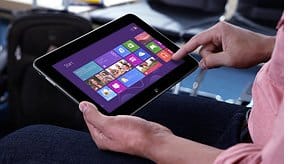Windows 8 and the Enterprise - Bring your own Device (BYOD)

 One of the big issues in the IT space is the growing acceptance by organizations that employees want to bring their own devices into the office. This trend, called “bring your own device” or most often called “BYOD” has been gaining traction over the last few years.
One of the big issues in the IT space is the growing acceptance by organizations that employees want to bring their own devices into the office. This trend, called “bring your own device” or most often called “BYOD” has been gaining traction over the last few years.
One of the largest issues with BYOD is a simple yet important issue and has to do with the most basic of IT Functions – security. Allowing users to bring in their own devices and connect to the corporate network is just asking for headaches for the information technology team.
In the past, IT has had to build special processes to allow users to bring in their own devices. This often meant that an IT professional would have to take the device, scan it for security issues and work through a large security process to get the new device onto the network.
With the release of Windows 8 for both mobile devices and PC’s, in addition to new Microsoft management features, the headaches found with BYOD might just be solved…or at least alleviated.
A few features that Windows 8 brings to the table to help with the BYOD headaches:
- Windows To Go – provides for a full Windows 8 desktop environment that can be stored on a USB drive. This would allow a user to bring in their own PC, but run a fully-functional, corporate sponsored version of Windows 8while on the company network..
- New Security Features – new Windows 8 security features provide for much more restrictions on files and applications
- Data Access – DirectAccess, a new Windows 8 feature, allows remote PC’s to connect to the enterprise infrastructure without using a VPN. This feature also allows for easier direct management of these remote computers.
While these are just a few of the new features in Windows 8, they are important ones and will go a long way toward removing BOYD headaches for IT professionals.
In addition to features within Windows 8 and new security/management features, new PC’s, tablets and phones are coming into the marketplace to help take advantage of mobility and BYOD. With the release of Windows 8, Dell has released a few enterprise and consumer devices with Windows 8 available. A few examples of some of Dell’s new machines:
- Dell XPS 12 – an ultrabook that could be quite useful at home or at work. The great thing about this machine is Dell sells it with Prosupport to allow it to fit nicely within the Enterprise.
- Dell XPS 10 – a tablet optimized for Windows 8 RT. A perfect machine for someone who’s always moving around and mobile
- Dell Latitude 6430 – another ultrabook built for business environments
By combining new features in Windows 8, new management functionality and new Windows 8 machines, IT professionals and consumers can start to alleviate some of the headaches that BYOD has historically meant for IT groups.
This is a paid post in conjunction with IDG and Dell


Comments ()